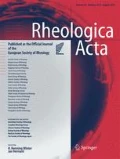Abstract
The previously reported algorithms for deriving line spectra (respondance time distributions) from synthetic or smoothed experimental responses is here extended to experimental data. The earlier algorithm was modified to improve performance in the presence of experimental errors. The effect of smoothing the data with the aid of the cubic spline function was examined.
The performance of the modified algorithm was studied comprehensively. Auto-predictions and cross-predictions of storage and loss compliances from the generated line spectra were in excellent agreement. In equally good agreement were the line spectra obtained from compliance data and from stress relaxation data obtained on the same material.
Similar content being viewed by others
References
Catsiff E, Tobolsky AV (1955) Stress-relaxation of polyisobutylene in the transition region. Colloid Sci 10:375–392
de Boer CA (1978) Practical guide to splines. Springer, Heidelberg
Emri I, Tschoegl NW (1993) Generating line spectra from experimental responses. Part I. Relaxation modulus and creep compliance. Rheol Acta 32:311–321
Ferry JD (1980) Viscoelastic properties of polymeric materials, 3rd ed. Wiley, New York, p. 277
Ferry JD, Grandine LD Jr, Fitzgerald RE (1953) The relaxation distribution function of polyisobutylene in the transition from rubber-like to glass-like behavior. J Apply Phys 24:911–916
Fitzgerald RE, Grandine LD Jr, Ferry JD (1953) Dynamic mechanical properties of polyisobutylene. J Appl Phys 24:650–655
Tschoegl NW, Emri I (1992) Generating line spectra from experimental responses. Part III. Interconversion between relaxation and retardation behavior. Intern J Polym Mater 18:117–127
Tschoegl NW, Emri I (1993) Generating line spectra from experimental responses. Part II. Storage and loss functions. Rheol Acta 32:322–327
Tschoegl NW (1989) The phenomenological theory of linear viscoelastic behavior. Springer, Heidelberg
Author information
Authors and Affiliations
Rights and permissions
About this article
Cite this article
Emri, I., Tschoegl, N.W. Generating line spectra from experimental responses. Part IV: Application to experimental data. Rheola Acta 33, 60–70 (1994). https://doi.org/10.1007/BF00453464
Received:
Revised:
Issue Date:
DOI: https://doi.org/10.1007/BF00453464




